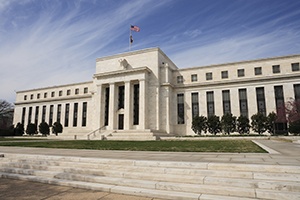 Yesterday, the FOMC decided to reduce the target range for the federal funds rate from 2–2.25 percent to 1.75–2 percent. As the headlines put it, the Fed cut rates by one-quarter of a percent. The headline version is certainly pithier, but the first version is more accurate—and gives a better sense of what actually happened: the Fed did not lower rates (contrary to the headlines), but it did lower the target range for its own lending operations.
Yesterday, the FOMC decided to reduce the target range for the federal funds rate from 2–2.25 percent to 1.75–2 percent. As the headlines put it, the Fed cut rates by one-quarter of a percent. The headline version is certainly pithier, but the first version is more accurate—and gives a better sense of what actually happened: the Fed did not lower rates (contrary to the headlines), but it did lower the target range for its own lending operations.
The difference here matters. Much of the discussion has been around what lower rates will mean for the economy and how the Fed just cut rates. The Fed knows better.
As an example, if you look at the past several years (until recently), the Fed had kept its target rate close to zero. But interest rates in the real world stubbornly remained positive, fluctuating up and down regardless of the Fed’s underlying target. More recently, even as the Fed raised its target rate, interest rates in the real world dropped substantially and quickly. The Fed does not control interest rates, although it very much wishes it did.
So, why is this news instead of a non-event? Why is the president calling on Twitter for the Fed to cut rates to zero, or even below? Why do we care?
Signpost for future of economy
We care because even though the Fed’s action does not signal rates are coming down immediately, it is a signpost of what the future likely holds for both rates and the economy. With the federal funds rate near zero, it took years for real-world interest rates to get there. But they eventually did, more or less. When the Fed starts cutting rates, it is a signpost that it sees economic trouble ahead. This move has historically been a good signal, the more so as the Fed has a bias toward keeping rates up. If the Fed is worried enough to actually cut, there is probably a good reason to worry ourselves.
The other reason we care is that the Fed’s base rate, which it changed yesterday, is essentially the foundation for all asset prices. Houses, stocks, bonds, gold, everything are all affected by the base Fed interest rate. When that rate goes down, in theory, most asset prices move up. As with interest rates, it isn’t quite that simple, and usually not that quick, but the trend can be set by such changes. There is an old Wall Street saying—“don’t fight the Fed”—and this trend is where it comes from.
What the cut tells us
Yesterday's rate cut, therefore, tells us a couple of things. First, the FOMC (i.e., the group of Fed members who make the decision) is worried about the economy. Second, rates are unlikely to increase too much in the near- to medium-term future, held down not just by the Fed’s decision but also by the expectation that more cuts may be coming. Third, these lower rates will likely act as a cushion for both the economy and the financial markets. All of this is good news going forward.
One additional thing worth noting from yesterday, however, is the level of public disagreement over the cut. The statement noted that one member wanted a half-point cut, while two opposed the cut. This level of dissent is rare, suggesting that the committee as a whole may not be as worried about the economy as previous cuts have indicated and that the economy may be in better shape than the cut would suggest. It also suggests that future cuts may be less likely than the market assumes. Therefore, while we will get the benefit of the current cut, that benefit may be constrained as the market tries to figure out whether more are coming.
The takeaway
Either way, the cut yesterday is likely a positive for the economy and markets and should be treated as such. That is the real takeaway from yesterday’s headlines.


 Print
Print

